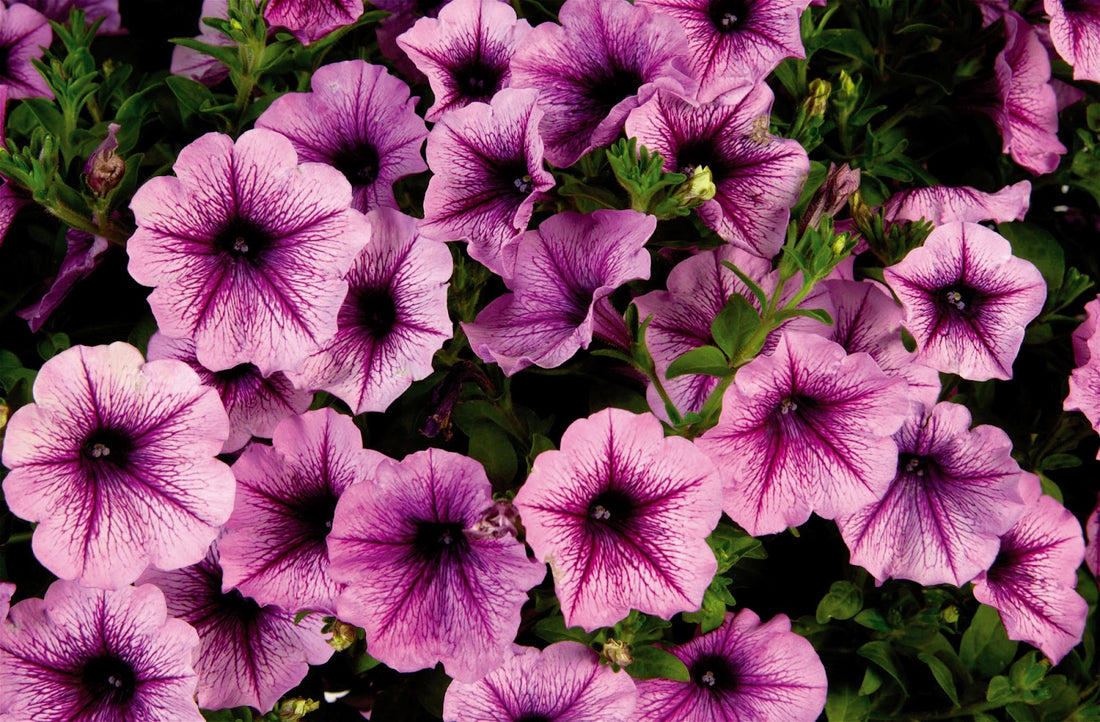Petunias are popular annuals that are prized for their vibrant colors, easy care, and long-lasting blooms. These plants are native to South America and come in a variety of colors, including pink, purple, red, white, and bi-colors.
Petunias are versatile plants that can be used in a variety of settings, from hanging baskets and window boxes to garden beds and borders. They are easy to grow, making them a great choice for beginners and experienced gardeners alike.
Here's a care guide for petunias to help you keep your plants healthy and looking their best:
Planting: Petunias prefer full sun, although they can tolerate some shade. They also like well-drained soil that's rich in organic matter. You can start petunias from seed or purchase seedlings from a nursery.
Watering: Petunias need regular watering to thrive, especially during hot weather. Water deeply and regularly, but avoid overwatering, which can cause root rot. Watering in the early morning or late afternoon is best.
Fertilizing: Petunias benefit from regular fertilization throughout the growing season. Use a balanced fertilizer every 2-3 weeks or follow the instructions on the package.
Deadheading: To encourage more blooms, deadhead your petunias regularly by removing spent flowers. This will also help prevent the plant from going to seed too early.
Pests and diseases: Petunias are generally healthy plants, but they can be susceptible to pests such as aphids, spider mites, and whiteflies. Treat infestations with insecticidal soap or neem oil. Diseases such as powdery mildew and botrytis can be prevented by providing good air circulation and avoiding overwatering.
Pruning: Petunias don't require pruning, but you can trim back leggy or straggly growth to encourage bushier growth and more flowers.
As the warmer weather approaches, it's the perfect time to indulge in planting annuals that will infuse your yard with vibrant colors for months on end. Among the top choices for summer flowers, petunias stand out with their long-lasting and vibrant blooms, vigorous growth, and versatile mounding, spreading, or trailing habits, making them ideal for delightful hanging baskets.
Petunia hanging baskets offer a world of possibilities with their numerous varieties to choose from. While a single petunia variety can certainly shine on its own, the real magic happens when you combine petunias with complementary or contrasting colors and patterns. Here are some expert tips to create your own spectacular petunia hanging baskets.
Petunia Hanging Basket Care:
Ideal Planting Time: Petunias adore the warmth and thrive during the sunny summer months. Make sure to plant them only after the last frost has passed in your area.
Sunlight Requirements: To ensure healthy growth and abundant flowering, petunias crave ample sunlight. Position your hanging baskets in a spot that receives at least 6 hours of direct sun daily.
Soil Essentials: Rich and well-draining soil is key to unlocking the full potential of petunias. Opt for high-quality potting mix like Proven Winners® Premium Potting Soil, providing your plants with all the necessary nutrients they need to thrive.
Fertilization: Petunias are rapid growers and demand regular feeding for lush foliage and prolific blooming. During planting, enrich the soil with Proven Winners® Premium Continuous Release Plant Food. Continue nurturing them with Proven Winners® Premium Water Soluble Plant Food every third time you water, ensuring non-stop flower power and vigorous growth.
Trimming Petunia Hanging Baskets: To address any leggy growth in your petunia hanging baskets, it's beneficial to trim back the plants to encourage branching. In mid-summer, prune them back by up to a third, promoting renewed growth and added vigor.
Let's dive deeper into the world of petunia hanging baskets and explore various aspects of their care, creative combinations, and maintenance to ensure they continue to dazzle with their vibrant blooms throughout the summer.
Choosing Petunia Varieties:
Petunias come in an array of colors, patterns, and growth habits. When selecting varieties for your hanging baskets, consider a mix of trailing, spreading, and mounding petunias to add depth and visual interest. Opt for complementary colors to create harmonious displays, or go for contrasting hues for bold and eye-catching combinations. Some popular varieties include Wave® petunias for their trailing habit, Supertunia® for their vigorous growth, and Cascadias™ for their beautiful cascading blooms.
Container Selection:
Choosing the right container is crucial for successful petunia hanging baskets. Ensure that your containers have sufficient drainage holes to prevent waterlogged roots. Hanging baskets made of sturdy materials like plastic-coated wire or fiberglass are excellent choices, as they are lightweight and durable.
Potting Mix and Soil Preparation: Use a high-quality potting mix, like Proven Winners® Premium Potting Soil, which provides excellent aeration, drainage, and nutrient retention. Before planting, prepare the soil by loosening it to encourage proper root growth. Mix in some slow-release fertilizer to give your petunias a head start.
Planting Techniques:
When planting petunias in hanging baskets, start by creating a central mound with the soil. Arrange your petunias around the edges, ensuring even spacing to allow room for growth. Plant the petunias at the same level they were in their nursery pots, and gently pat the soil around them to secure them in place.
Watering and Moisture Management:
Water your petunia hanging baskets consistently to keep the soil evenly moist. Hanging baskets tend to dry out faster than in-ground plantings, so it's essential to monitor their water needs regularly. Avoid waterlogging, as petunias don't thrive in overly wet conditions. Applying a layer of mulch on top of the soil can help retain moisture and reduce evaporation.
Deadheading and Pruning:
Petunias benefit from deadheading, which involves removing spent flowers regularly. This practice encourages continuous blooming and prevents seed formation, diverting the plant's energy into producing more blooms. Additionally, pruning back leggy growth in mid-summer will encourage branching, leading to a more compact and lush appearance.
Fertilization:
In addition to slow-release fertilizer during planting, supplement your petunias' nutrient needs with water-soluble fertilizer, such as Proven Winners® Premium Water Soluble Plant Food, every few weeks. This regular feeding will keep the plants healthy and promote abundant flowering.
Pests and Disease Management:
While petunias are relatively hardy, they can still be susceptible to pests like aphids, slugs, and spider mites. Keep a close eye on your hanging baskets and take prompt action if you notice any signs of infestation. Regularly inspect the foliage for signs of disease and remove any affected plant parts immediately to prevent further spread.
Seasonal Care:
As the summer progresses, petunias may become leggy or overgrown. Don't hesitate to trim them back to maintain their shape and encourage new growth. Replenish nutrients in the soil by adding slow-release fertilizer or compost to ensure they continue to flourish throughout the season.
Creative Combinations:
Experiment with various petunia combinations to create stunning displays. Pair petunias with other annuals like geraniums, lobelia, bacopa, or sweet potato vine.
Additionally, consider adding trailing plants like ivy or bidens to enhance the cascading effect of your hanging baskets.
By following these comprehensive care tips and getting creative with your petunia hanging baskets, you'll create a captivating and colorful garden display that will be the envy of the neighborhood. Enjoy the continuous burst of blooms and the joy of tending to your thriving petunia hanging baskets all summer long. Happy gardening!
Petunia FAQ’s
How long do petunias last in hanging baskets?
As long as plants are properly cared for, petunia baskets will last from planting until frost.
How do you take care of petunias in a hanging basket?
Because water and nutrients leach out of hanging baskets more quickly than for plants in the ground, baskets will need more frequent care.
How do you keep petunia baskets looking good?
To keep petunia flower baskets looking their best, make sure they receive full sunlight, regular water, fertilizer and pruning.
How do you keep petunia baskets full?
Pinch tips back for more branching. Prune plants if they become lanky and fertilize to stimulate new growth.
How do you keep petunia baskets blooming?
Petunias are heavy feeders. Apply a slow-release fertilizer at the time of planting and supplement with a water-soluble fertilizer that contains a higher percentage of phosphorus and potassium to promote more blooms. Though older varieties require deadheading for continuous bloom, many modern hybrids are self-cleaning.
How many petunias are in one hanging basket?
It depends on how big the basket is and the mature size of the plants. For a 12-14 inch basket, use 4-6 starter plants in 4-inch pots.
What are the best petunias for hanging baskets?
Mounding, spreading or trailing petunias are best for baskets. Try Proven Winners® Supertunia® series, which come in a range of colors, patterns and forms. Check out these pretty purple petunias.
How often to water a petunia hanging basket?
Petunias do best with consistent water. Hanging baskets dry out quickly, so it’s important to check them frequently. If the soil feels dry 1-2 inches down, then it’s time to water. During hotter weather, this may mean watering once or twice a day. In cooler weather, reduce the amount of water and don’t allow soil to remain soggy.

